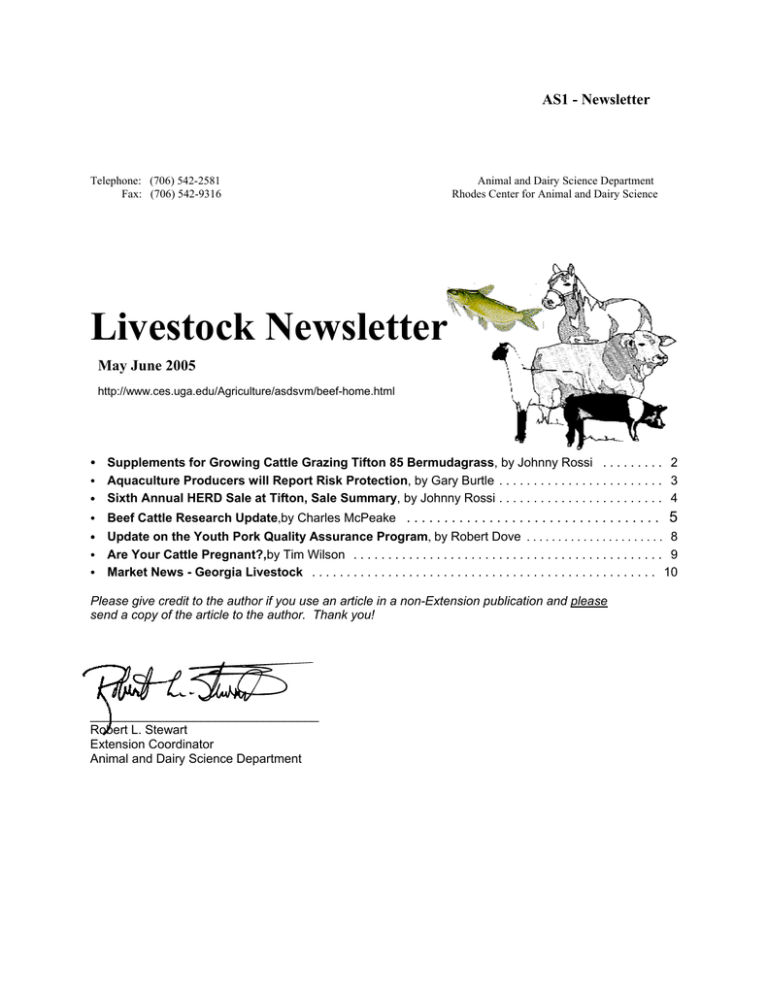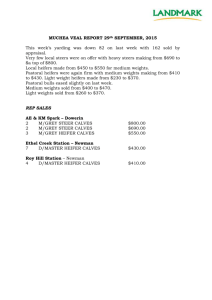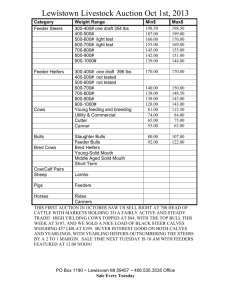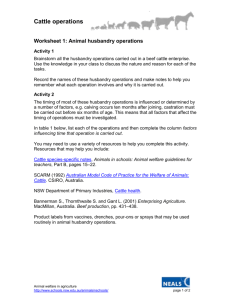AS1 - Newsletter
advertisement

AS1 - Newsletter Telephone: (706) 542-2581 Fax: (706) 542-9316 Animal and Dairy Science Department Rhodes Center for Animal and Dairy Science Livestock Newsletter May June 2005 http://www.ces.uga.edu/Agriculture/asdsvm/beef-home.html C Supplements for Growing Cattle Grazing Tifton 85 Bermudagrass, by Johnny Rossi . . . . . . . . . 2 C Aquaculture Producers will Report Risk Protection, by Gary Burtle . . . . . . . . . . . . . . . . . . . . . . . . 3 C Sixth Annual HERD Sale at Tifton, Sale Summary, by Johnny Rossi . . . . . . . . . . . . . . . . . . . . . . . . 4 C C C C Beef Cattle Research Update,by Charles McPeake . . . . . . . . . . . . . . . . . . . . . . . . . . . . . . . . . . 5 Update on the Youth Pork Quality Assurance Program, by Robert Dove . . . . . . . . . . . . . . . . . . . . . . 8 Are Your Cattle Pregnant?,by Tim Wilson . . . . . . . . . . . . . . . . . . . . . . . . . . . . . . . . . . . . . . . . . . . . . 9 Market News - Georgia Livestock . . . . . . . . . . . . . . . . . . . . . . . . . . . . . . . . . . . . . . . . . . . . . . . . . . 10 Please give credit to the author if you use an article in a non-Extension publication and please send a copy of the article to the author. Thank you! _________________________________ Robert L. Stewart Extension Coordinator Animal and Dairy Science Department LIVESTOCK NEWSLETTER May/June 2005 AS-1 Supplements for Growing Cattle Grazing Tifton 85 Bermudagrass Johnny Rossi Extension Animal Scientist Tifton 85 is hybrid bermudagrass that has greater yields and digestibility than Coastal bermudagrass. Calves require supplementation with a highly digestible grain source when grazing bermudagrass pastures to gain at an economical rate. Without supplementation, stocker calves usually gain about 1.0 lb per day when grazing Coastal bermudagrass, but increases to 1.5 pounds or greater per day when grazing Tifton 85 bermudagrass. Research has shown that calves should be fed a high protein (> 20%) supplement when grazing bermudagrass pastures. Several research studies have examined the effects of feeding high protein supplements to stocker calves grazing Coastal and Tifton 85 bermudagrass. A study was conducted at Texas A&M University to evaluate stocker calf gains on Coastal and Tifton 85 bermudagrass with or without supplementation. Fall born steers and heifers were weaned in June and started grazing Tifton 85 bermudagrass pastures (three head/acre) on July 3. Calves in the supplement groups were fed two pounds per day of a 28% crude protein supplement that consisted of a 1:1 ratio of soybean meal to corn containing an ionophore (Rumensin®). Results of the experiment are shown in Table 1. Calves grazing Tifton 85 bermudagrass gained approximately 0.75 pounds per day more than calves grazing Coastal bermudagrass. Supplementation increased gains by one-third of a pound and feed conversions were 6.1 pounds of feed for calves grazing Tifton 85 bermudagrass and 6.9 pounds of feed for calves grazing Coastal bermudagrass. This study clearly shows that Tifton 85 is superior to Coastal bermudagrass for stocker calves. A second study was also conducted at Texas A&M University to evaluate supplement level for stockers grazing Tifton 85 bermudagrass. Fall born steers and heifers were weaned in June and started grazing Tifton 85 bermudagrass pastures on July 1. Calves weighed 760 pounds when the trial started. Calves were stocked at 3.6 head per acre and fed a supplement at either 0, 0.2, 0.4, or 0.8% of body weight for 90 days. The supplement was 36% crude protein and consisted of a 2:1 ratio of soybean meal to corn. The supplement contained an ionophore (Rumensin®) and calves were implanted prior to the start of the experiment. Results of the experiment are shown in Table 2. Daily gains increased with increasing supplement level. Efficiency of supplementation was not reduced when fed up to 0.8% of body weight. Thus, supplement cost per pound of gain was similar among supplement treatments. Both trials showed that feed efficiency was six to seven pounds of feed per pound of gain for calves fed the high protein supplements. These supplements would cost $0.08 to $0.10 per pound in most years. This would result in supplement cost of gain between $0.50 and $0.70 per pound of gain. You must account for both supplement cost of gain and the price discount received for heavier supplemented 2 calves when deciding how much supplement to feed. When grazing Tifton 85, stocker calves should be fed supplement at 0.25 to 0.5% of body weight to achieve gains of 1.8 to 2.2 pounds per day. Supplementation rates of 0.5 to 1.0% of body weight should yield gains of 2.2 to 2.6 pounds per day. Adequate forage must be available at all times for calves to achieve these gains. Table 1. Daily gain, gain per acre, and supplement efficiency of stocker calves grazing Tifton 85 or Coastal bermudagrass and fed 2 lb/day supplement. Pasture Daily gain Gain per acre Lb feed per lb of gain Coastal, no supplement 1.11 279 ---- Coastal + supplement 1.43 360 6.9 Tifton 85, no supplement 1.85 465 ---- Tifton 85 + supplement 2.21 550 6.1 Table 2. Performance, supplement intake, and supplement efficiency of stocker calves grazing Tifton 85 bermudagrass. Supplement, % of body weight Item 0.0 0.2 0.4 0.8 Daily gain, 90 days 1.55 1.79 2.02 2.44 Supplement intake, lb/day ---- 1.64 3.22 6.44 Supplement efficiency, lb feed:lb added gain ---- 6.83 6.85 7.24 3 Aquaculture Producers Will Report Risk Protection Gary J. Burtle A nationwide survey will be conducted this summer to determine the risk of losing fish from aquaculture operations. USDA Risk Management Agency will be contacting producers this summer to complete a survey that pertains to fish diseases, bird predation, toxic algae, power outages, oxygen depletion, pesticides, and other perils experienced while farming catfish, baitfish, or trout. The potential for financial losses from these perils will be examined as well as possible management methods to reduce the losses. The National Risk Management Feasibility Program for Aquaculture (NRMFPA) was created in 2001 as a partnership program between the USDA Risk Management Agency (RMA) and Mississippi State University to investigate the feasibility of developing risk-reducing products such as peril specific production loss insurance for the four highest-valued aquaculture industries (catfish, salmon, trout and baitfish, as of 1999). To accomplish this goal the NRMFPA must collect the frequency and magnitude of production loss events on aquaculture farms. In addition, risk classification factors must be identified. Specific historical information on fish losses and risk management practices do not exist for any of the aquaculture industries, which presents additional challenges to developing appropriate risk protection products. The NRMFPA, in collaboration with the National Agricultural Statistics Service (NASS), is conducting an aquaculture survey endorsed by the Catfish Farmers of America, the U.S. Trout Farmers Association, and the Arkansas Bait and Ornamental Fish Growers Association. Over 1,900 catfish, trout, and baitfish producers will be contacted during the summer of 2005 and asked to report on historical production losses, anticipated future losses, and other subjects essential to developing sound, appropriate insurance policies. These surveys will serve as a key component in determining if production loss insurance for catfish, baitfish, and trout can be offered through the RMA. In addition, the results from the survey may identify practices that reduce the risk of losses on the farm, which will immediately benefit these aquaculture industries. For more information about the NRMFPA and the RMA please access their respective websites at: http://www.agecon.msstate.edu/Aquaculture and http://www.rma.usda.gov. If you have any question regarding the NRMFPA or the survey please contact Terry Hanson, hanson@agecon.msstate.edu or Steve Sempier, sempier@agecon.msstate.edu, National Risk Management Feasibility Program for Aquaculture, Mississippi State University, Department of Agricultural Economics. Sixth Annual HERD Sale at Tifton, Sale Summary Johnny Rossi Extension Animal Scientist The Sixth Heifer Evaluation and Reproductive Development Sale was held at the Tifton Bull Evaluation Center in Irwinville on April 19, 2005. In all, 23 consignors entered 179 heifers in the program at the beginning of October. A total of 90 pregnant heifers were sold for an average of $1280. There was a good crowd with a total of 27 buyers from Georgia, Florida, and Mississippi. 4 The top-selling heifer was consigned by David Pitts and sold for $2,000. The largest number of heifers purchased was 18 by Pete Waller of Ottowa Farms in Bloomingdale, GA. Heifers were heat-synchronized using CIDR’s and bred A.I. for two heat cycles to a calving ease Angus bull. A clean-up bull was put with each group of heifers for two more cycles. The A.I. conception rate was 73%, and the overall pregnancy rate was 88%. Heifers confirmed pregnant by AI averaged $1314 and heifers confirmed pregnant by natural service averaged $1135. The test is designed to maintain a moderate growth rate of approximately 1.5 pounds per day to achieve a target weight (65% of estimated mature) at the beginning of the breeding period on January 1. Heifers were fed high quality Coastal bermudagrass hay (9% crude protein) plus 6 lb/d soyhulls pellets and 3 lb/d corn gluten feed. Heifers gained 1.8 lbs/day during the program which began 80 days prior to breeding and ended 120 days after the start of the breeding period. A free choice mineral containing an ionophore (Bovatec®) was fed. In addition to weight gain, heifers are evaluated for reproductive tract maturity, disposition, pelvic area, and frame score. The HERD program would not be possible without the support of the HERD Team. This group of Extension agents forms guidelines, promotes the program and does a large portion of the work. This years program was a great success and many consignors and other cattle producers are beginning to use the HERD program protocol on their cattle at home. Plans will begin soon for the 2005-2006 HERD program with heifers being delivered in the fall. If you are interested, contact your local Extension agent or Johnny Rossi at 229/386-3407 or e-mail at jrossi@uga.edu. Beef Cattle Research Update Dr. Charles McPeake Extension Beef Specialist Winter 2005 Summarized by Michigan State University personnel Following are reviews of research projects recently reported at scientific meetings or in scientific publications. Please feel free to use as you see fit. BREEDING/GENETICS EPDs of Sires Compared Favorably With Actual Performance of Progeny Even though expected progeny differences (EPDs) have been around since the mid-1980s, some skepticism still exists about their effectiveness as a selection tool. In this study, Kansas State Univ. researchers analyzed data on 3600 Charolais-sired calves in 31 commercial herds to compare progeny performance with the EPDs of their sires. Traits analyzed were birth weight (BW) and weaning weight (WW). All of the progeny were crossbreds. They were sired by 224 purebred Charolais bulls having average accuracies of 0.79 and 0.75 for BW and WW, respectively. 5 Correlations for sire effect on BW and WW were favorably related to actual progeny performance with correlations of 0.59 and 0.39, respectively. The authors noted that the lower WW response may have been due to differences in postnatal management practices between commercial and seedstock herds. This study further adds to the body of research validating the use of EPDs as an effective selection tool for BW and WW in commercial herds (Clark et al. 2004. Prof. Anim. Sci. 20: 503). British and Continental Breeds Still Differ Significantly in Carcass Traits but Are Now Similar in Growth U.S. MARC scientists recently reported final carcass and meat palatability results of Cycle VII of the Germ Plasm Evaluation (GPE) program. The study involved a total of 649 F1 steer calves sired by bulls representing the seven breeds having the highest number of registrations in the U.S. Calves were born in 1999 and 2000, and were finished and harvested at a final age of approximately 15 mos. Represented were three British (Angus, Hereford, Red Angus), and four Continental breeds (Charolais, Gelbvieh, Limousin, and Simmental). Following is a summary of data adjusted to a constant age of 445 days. · Between breedtypes, the British and Continental breed groups did not differ significantly in live weight or hot carcass weight. · British-sired steers were significantly fatter (0.55 vs. 0.35 in. backfat), had smaller ribeye areas (12.31 vs. 13.75 sq. in.), and lower retail product yields (59.7 vs. 63.5%) than Continental-sired steers. · A significantly higher percentage of carcasses from Red Angus- and Angus-sired steers graded USDA Choice (90 and 88%) than carcasses from all other sire breeds (57 to 66%). · Ribeye steaks from Angus-sired steers had the lowest shear force values followed closely by Hereford- and Red Angus-sired steers. Continental-sired steers tended to have higher shear force values. · Sensory panel ratings for tenderness and beef flavor did not differ significantly among any of the seven sire breeds. The authors concluded these results showed that over the last 25 to 30 years, the Continental breeds are still leaner, heavier-muscled, and have higher-yielding carcasses than British breeds with less marbling than Angus or Red Angus, but British breeds have caught up in growth rate (Wheeler et al. 2005. J. Anim. Sci. 83:196). Heritabilities and Correlation Estimates of Shear Force and Carcass Traits in Angus-, Charolais-, Hereford-, and Simmental-Sired Cattle In a collaborative study, Iowa State, Kansas State, and Cornell Univ. researchers determined heritabilities and correlations of Warner-Bratzler shear force (WBSF) and carcass traits from 3360 Angus-, Charolais-, Hereford-, and Simmental-sired cattle in the National Cattlemen’s Carcass Merit Project. These data are unique in the scientific literature because of the large amount of field data that was collected under commercial conditions. Table 1 summarized heritabilities for the four breeds adjusted to a constant age. 6 Table 1. Heritabilities of WBSF and carcass traits in four breeds Breed Item Angus Charolais Hereford Simment al WBSF .34 .43 .12 .16 Marbling score .43 .30 .11 .44 Carcass wt. .73 .21 .20 .45 Fat thickness .16 .35 .25 .23 Ribeye area .56 .23 .34 .30 As shown in Table 1, heritabilities for most traits were in the moderate range (.20 - .50). A few were low: WBSF in Hereford and Simmental; marbling score in Hereford; and fat thickness in Angus. Carcass weight and ribeye area heritabilities were high in Angus. These results suggest that these traits would respond well to selection pressure in most instances. Although not shown here, genetic correlations revealed that selection for increased marbling in Angus-, Charolais-, and Hereford-sired cattle would be expected to be associated with a small correlated improvement in tenderness, but would not be in Simmental. Other genetic correlations varied widely among the breeds. The authors cautioned that some reservations should be used in interpreting these results due to the limited number of sires used in the data sets (Minick et al. Can. J. Anim. Sci. 84: 599). COW-CALF Developing Replacement Heifers to 50 or 55 Percent of Mature Body Weight For many years, it was recommended that yearling heifers should be developed to reach 60-65% of their projected mature body wt. (MBW) prior to the start of their first breeding season. Recent research has indicated that this recommendation may be lowered to 55% of MBW without jeopardizing first- and second-calf conception rates. In a 3-yr. Univ. of Nebraska study, a total of 261 March-born heifer calves were developed to reach either 55% of MBW prior to a 45-day breeding season, or 50% of MBW prior to a 60-day breeding season. Extending the breeding season by 15 days for the heifers developed to 50% of MBW resulted in pregnancy, calving, and weaning rates that were comparable to those of the heifers that were developed to 55% of MBW. Moreover, a reduction in development costs in the 50% system more than offset the reduced income from lighter weaning weights caused by later calving dates, resulting in lower costs to produce one pregnant yearling heifer or 2-year-old cow. These results suggest that developing heifers to 50% of MBW prior to their first breeding season would appear to be a feasible alternative for some producers (Creighton et al. 2005. Univ. of Nebraska Beef Cattle Report MP 83A). Early vs. Conventional Weaning Age: A Review An extensive review of early weaning research was recently conducted by animal scientists Fred and 7 Todd Thrift, Universities of Kentucky and Florida, respectively. More than seventy studies were cited in their paper. Following is a brief summary of their review (Prof. Anim. Sci. 20: 461). · Age at early weaning (EW) ranged from 3 to 5 mos. Age at conventional weaning (CW) ranged from 6 to 8 mos. · EW of calves can be of particular benefit in conditions involving subpar reproduction such as might occur in severe drought or attempts to rebreed thin, first-calf heifers. · To avoid health problems and promote growth after EW, unique management practices are needed for EW calves. · If EW calves are fed some form of concentrate diet from time of EW until the age at which they would normally be CW, their body wt. will be equal to or greater than that of calves who nursed their dams and were conventionally weaned. · Feedlot avg. daily gain and carcass wt. tend to be lower, yield grade is equal, and the percentage of carcasses grading Low Choice or higher tends to be equal or greater for EW cattle compared to CW cattle. · When the stress of lactation is eliminated by EW, cows gain body wt. and condition, and pregnancy rate is increased. · Subsequent preweaning productivity is similar for cows that had been weaned early when they were calves to those that had been weaned conventionally as calves. Update on the Youth Pork Quality Assurance program C. Robert Dove Effective January 1, 2005, changes were made to the Youth Pork Quality Assurance (YPQA) program. The most significant change is the age a youth is eligible to participate in the YPQA program. As of January 1, 2005, any youth who is between 8 and 18 on January 1 is eligible to participate in the YPQA program. In previous years the control age has been 9. Youth who are under 8 years of age on January 1, will have to show under the Level III PQA of a parent or guardian. Youth under the age of 8 are strongly encouraged to attend the YPQA training. Effective January 1, 2006, only those local educators who have been trained by the State Youth Coordinator will be able to submit the names of youth for certification. This change makes it mandatory that all youth educators be trained by the State Youth Coordinator. If you need to be trained in the YPQA program, please contact Dr. Dove. All local educators must attend a refresher training once every 3 years. The YPQA program consists of 10 Good Production Practices. The YPQA training must address all 10 of these annually in a program that lasts at least one hour. The YPQA program is designed so that the annual training addresses three of the Good Production Practices in depth each year, so that over a three year period the first nine Good Production Practices are covered in depth. Good Production Practice 10 should be covered every year. Interactive and/or experiential learning activities are required in each training. Only those materials that have been provided or approved by National Pork Board are to be used in the YPQA training sessions. The YPQA program allows 8 students to test out of the yearly recertification. However, at the current time, Georgia Junior rules require that every student be recertified every year. Additional information and training materials can be found on the web at: http://www.porkboard.org/youthPQA/youthPQA.asp If you have any questions concerning the YPQA program and its administration in Georgia, please call Dr. Do Are Your Cattle Pregnant? Tim Wilson Extension Animal Scientist – Beef Cattle Now that summer is here, most cattlemen have finished the breeding season and are now focused on summer forages and haying. As you check your cows each morning and evening, you take notes for body condition, sickness, pasture condition, lameness and mounting activity. Often when we see one cow or heifer mounting another, it is assumed that the female that is being mounted is open. Although this is the rule, there are often exceptions. Many scientists, consultants and producers refer to the age old research published in the Journal of Dairy Science in 1958 that determined that cattle may demonstrate estrous behavior while being pregnant. This research may seem ancient to many, but researchers in England confirmed this work in 1989. Although there are many estrous detection tools that can be used to detect heat, these researchers visually observed pregnant cattle for 30 minutes four times per day. They found that estrus-like activity occurred in 5.7% of the observed pregnant cows for a combined total of 43 events. When comparing all cows that were mounted, pregnancy status was undistinguishable whether pregnant or non-pregnant. Not only did pregnant cows allow others to mount, seven of nine pregnant cows allowed a bull to mount willingly. Computer technology has improved estrus detection with the development of radiotelemetry. Although many estrous detection aids are very beneficial, few offer detailed information about mounting activity. Radiotelemetry allows for 24-hour estrous detection defining the time, number and duration of mounts. In 2004, researchers from Texas A&M University reconfirmed that pregnant cattle may demonstrate estrous behavioral characteristics similar to non-pregnant cattle with this technology. Their research involved artificially inseminating 21 prepubertal Angus-sired heifers. All heifers were equipped with radiotelemetry devices for to use for analysis. Conception occurred in nine of these heifers. Estrous detection continued after confirmation of pregnancy and of those pregnant a total of 73 estrus events were recorded. All of these researchers were able to confirm that pregnant cattle may exhibit estrous behavior similar to non-pregnant cattle. The point to remember is that some pregnant cattle may show every behavioral characteristic of being in estrus but still be pregnant. If this activity is demonstrated, you may want to have them pregnancy checked a second time before trying to initiate synchronization using hormones or culling her due to reproductive problems. If you have any questions related to this topic or any beef management practice, contact your county extension agent, veterinarian or me at (912) 681-5639. 9 WEEK ENDING: 6-03-05 information. GEORGIA CATTLE: The Cooperative Extension Service would like to thank Terry Harris for submitting this RECEIPTS: 8500 FEEDERS SLAUGHTER COWS % LEAN LAST WK 9,800 STEERS YEAR AGO 12,200 MED & LARGE 1 HEIFERS 148.00-172.00 300/350 LBS 137.80-156.00 134.00-157.50 350/400 125.00-145.00 125.00-148.50 400/450 119.00-137.00 116.00-138.00 450/500 114.00-137.00 110.00-131.00 500/550 110.00-129.00 108.00-128.00 550/600 101.00-120.00 104.00-128.000 600/650 100.00-113.00 100.00-113.000 650/700 98.00 -109.00 75-80% 850-1200 LBS 52.00-61.00 80-85% 850-1200 LBS 55.00-62.50 80-86% OVER 1200 LBS 54.50-66.50 85-90% 800-1200 LBS 52.00-62.00 5 Area Daily Wtd Average - Texas/Oklahoma; Kansas; Nebraska; Colorado; and Iowa/So Minnesota Feedlots: Steers...Select/Choice 65-80% Weighted Average Price Range 83.00-88.50_____ Heifers..Select/Choice 65-80% Weighted Average Price Range 84-85.50______ By-Product Drop Value (Steer)...Hide and Offal Value 8.23 /cwt. Box Beef Cut-Out Value Choice 1-3 550/750 LBS. 144.21 Select 1-3 550/700 LBS. 136.32 Georgia Hogs: GA-FL-AL Direct Area Receipts 2500 US 1-2 220/260 LBS. 46.00-48.00 FEEDER PIGS GEORGIA Trends Steady Sows 300/500 LBS. TENNESSEE ___ 500-UP GEORGIA US 1-2 35/40 LBS. 55-60 40/45 60/65 45/50 65/70 50/55 70/80 IOWA-SOUTHERN MINNESOTA DIRECT HOGS: RECEIPTS BARROWS & GILTS 49-51% LEAN 185 LB CARCASSES RANGE 10 55-69.65 TENNESSEE TRENDS .89 Higher WTD AVG. 67.66




